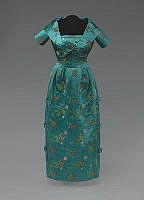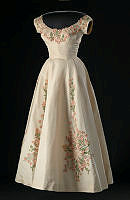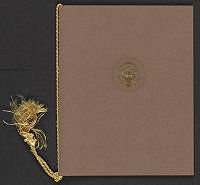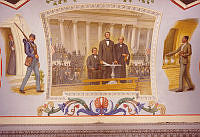Rubenstein Center Scholarship
The Williams Family
This article is part of the Slavery in the President’s Neighborhood initiative. Explore the Timeline
In 1818, John Gadsby was assessed and taxed for owning thirty-six enslaved individuals in Baltimore—including two young women named “Maria” and “Kezia.”1 These names also appear twenty-six years later in a property inventory taken after Gadsby’s death. Maria Williams is listed along with her children Martha, Mary Ellen, and James; Keziah Williams, with her children Mary and William.2 But how did these two sisters end up in Washington? What happened to them after John Gadsby’s death and after slavery was abolished in the District? This article explores the history of the Williams family who lived and worked at Decatur House on Lafayette Square.

This photograph shows Decatur House between 1918 and 1920. The attached service wing behind the house was used as a slave quarters for most of the antebellum period. John Gadsby purchased the home in 1836.
Library of CongressFor nearly forty years, John Gadsby had operated lodging establishments in Alexandria, Baltimore, and Washington, D.C. In all of his hospitality businesses, Gadsby relied heavily on enslaved people to cook, clean, and attend to his guests. As a result, he frequently purchased or hired out enslaved individuals. In 1808, he left Alexandria for Baltimore, where he leased the Indian Queen Tavern. According to the 1810 census, there were forty-five enslaved people listed with John Gadsby at the establishment—probably one of the largest enslaved staffs in the city at that time.3 According to Samuel Breck, a visitor who stayed at the Indian Queen in September 1809, the inn could accommodate “two hundred lodgers, and has two splendid billiard-rooms, large stables, and many other appendages. The numerous bedchambers have all bells, and the servants are more attentive than in any public or private house I ever knew.” Breck noted that there was only one other public house in Baltimore that was “equally well conducted” but admitted it was “of less magnitude” than the Indian Queen.4
Breck also remarked that the hotel was kept “in a style exceeding anything that [he had] seen in Europe or America.” Gadsby’s elegant accommodations and gracious hospitality—along with the many improvements he made to the property—eventually caught up with him. By 1817, he was trying to sell his lease and a “very valuable tract of land” just outside the city. The tract was “nearly 900 acres” and about half of it was “in a state of productive cultivation…the remainder [was] covered in fine timber.”5 Gadsby’s decision to sell the lease and his land suggests he was struggling financially. A year later, tax records indicate that he owned thirty-six enslaved people. By 1820, Gadsby was no longer at the Indian Queen and most likely living on the farm he previously tried to sell, along with his family, fifteen enslaved people, and three free African Americans.6 While we do not know for certain what happened to the other twenty-one enslaved people, Gadsby likely sold some of them in order to pay his debts. In March 1822, notice was given “to the creditors of John Gadsby, an insolvent debtor” in the city and county of Baltimore.7

In the 1810 census, forty-five enslaved people were listed with John Gadsby, who was operating the Indian Queen Tavern in Baltimore.
National Archives and Records AdministrationShortly thereafter, John Gadsby left Baltimore for Washington, D.C. in 1823. For three years he ran the Franklin House Hotel before moving on to his most successful venture—the National Hotel. He again required a large workforce—at least thirty-nine enslaved individuals and four free African Americans according to the 1830 census.8 There were also six enslaved women between the ages of ten and twenty-three in his household.
In 1836, John Gadsby purchased his retirement home on Lafayette Square for $12,000. The house, located on the northwest corner of the park, was originally built in 1818-1819 for Commodore Stephen Decatur and his wife Susan. After Stephen’s unexpected death in 1820, Susan rented the property to prominent tenants such as Baron Hyde de Neuville, French Minister to the United States, and Baron de Tuyll, the Russian Minister to the United States. A succession of secretaries of state soon followed—Henry Clay, Martin Van Buren, and Edward Livingston. The last occupant before Gadsby was Sir Charles Richard Vaughan, the British Minister to the United States.9 Click here to learn more about the enslaved households of President Martin Van Buren.
When Gadsby retired from the National Hotel in 1836, he moved to Decatur House and brought with him a small staff of around ten enslaved people. Four years later, the Gadsby household included at least eleven enslaved people and two free African Americans. There were only two enslaved women between the ages of twenty-four and thirty-five living at Decatur House at that time.10 Based on the documented evidence, these women were likely Maria and Keziah. They had been born in Maryland and were either purchased by John Gadsby or born to a mother enslaved by him. At some point, they were separated from their family and taken to Washington to work in Gadsby’s businesses.

This photograph shows a list of enslaved individuals who were counted as part of the property inventories for John Gadsby in 1844. Sisters Maria and Keziah Williams had five children between the two of them. Mary Ann, James, and William were likely born into slavery at Decatur House.
White House Historical Association/National ArchivesUpon John Gadsby’s death in 1844, he bequeathed seventeen enslaved individuals to his wife Providence—including seven members of the Williams family. Maria and Keziah were sisters, and the mothers of Martha (8), Mary Ellen (5), James (3), Mary (8), and William (6). Martha and Mary would have been born sometime around 1834, just a couple years before Gadsby retired from the hotel. While we don’t know for certain why Maria, Keziah, and their young daughters were taken from the National Hotel, perhaps it was because they were mothers with infant children. The other three Williams children—Mary Ellen, James, and William—were likely born into slavery at Decatur House. There is no indication of a husband or father for either family in Gadsby’s inventory, which suggests that the fathers of these children were either owned by someone else or free men. These children inherited their enslaved status from their mothers, as well as the surname Williams.11
According to the 1850 Slave Schedules, twelve enslaved people lived with Providence Gadsby at Decatur House. Based on the estimated ages, it appears that Maria, Keziah, Mary Ellen, and James were still there. Martha Ann, Mary Frances, and William were not present. The girls would have been about fourteen years old at that time; William would have been about twelve. While we don’t know what happened to them, it is possible that they were sold, hired out elsewhere, escaped, or a family member bought their freedom. Providence Gadsby’s death eight years later sheds some light on this mystery. Her probate records list the names of sixteen enslaved individuals, including Maria Williams, Jim Williams, and Lewis Williams. There is a Mary Frances Long listed as well, and this person very likely was Mary Frances Williams since the names and ages match up. Martha Ann and William are still absent, and so is Keziah and her niece Mary Ellen.12 At some point between 1850 and 1858, the Williams sisters—who had spent most of their lives together—were separated from each other.

This photograph shows a list of enslaved individuals who were counted as part of the property inventories for Providence Gadsby, John Gadsby's wife, in 1858. The names that are bolded appear in both John and Providence's property inventories. Keziah and William Williams are no longer present; Mary F. Williams may have married and become Mary Frances Long. At some point between 1850 and 1858, sisters Maria and Keziah were separated from each other.
White House Historical Association/National ArchivesIn 1862, Congress passed legislation to emancipate the enslaved population of Washington, D.C. The law also provided compensation to slave owners for their loss of property so long as they filed a petition with the commissioners. These documents tell us more about the last enslaved members of the Williams family at Decatur House. John Gadsby’s daughter, Augusta McBlair, filed a petition in May 1862 for compensation for six enslaved individuals—one of whom was matriarch Maria Williams. According to the record, Maria was “about 5 feet 6 inches high,” had a “high Brown complexion, scarred face, Black hair & eyes.” She was “a capital cook & laundress, commands $8 per month, and is valued at $800.”13 Based on her description, Maria would have been working in the large kitchen and laundry on the first floor of the Decatur House service wing and living upstairs in the Slave Quarters. Click here to see a virtual tour of the Decatur House Slave Quarters.
James Williams also received his freedom through this process when Mary Augusta Gadsby, wife of William Gadsby and daughter-in-law to John and Providence, filed a similar petition. Mary described James as about nineteen-years-old with “black hair & eyes, thick lips, [a] gruff voice, and about five feet eight inches high.” He was “a first class waiter, a superior cook, & a thorough house servant and he has no mental, moral, or physical infirmity.”14 Three months later, Maria’s youngest son, Lewis, received his certificate of freedom with John McBlair serving as witness. McBlair participated on behalf of his sister-in-law Julia Ten Eyck, who was living in New Jersey at the time but still owned three enslaved individuals. There isn’t much detail about Lewis besides his age, height, and skin complexion—but he did make his mark on the document to receive his certificate of freedom.15 These petitions tell us that Maria, James, and Lewis were separated upon Providence’s death and divided among the Gadsby children. Fortunately, they remained in Washington, D.C., and therefore were eligible for freedom in 1862.

This petition was filed by Mary Augusta Gadsby, the wife of William Gadsby, on May 19, 1862. She sought compensation from the government for the loss of James Williams, "a first class waiter, a superior cook, & a thorough house servant."
National Archives, Record Group 217Twenty-one-year-old “James H. Williams” appears in Civil War draft registration records the following summer—he was unmarried, living on I Street NW and working as a servant at that time.16 Three years later, on October 25, 1866, eighteen-year-old Lewis Williams signed up to join the United States Army. He was assigned to the 40th Infantry 25th Regiment, one of four new regiments created for African-American soldiers after the Civil War. Williams was sent to Ship Island, Mississippi, where he served at the Fort Massachusetts garrison. After he finished his three-year enlistment, Private Williams was discharged from service on October 25, 1869.17 He headed back to Washington, D.C., but it is difficult to determine if the family was reunited prior to 1870.

On October 25, 1866, eighteen-year-old Lewis Williams enlisted in the United States Army. He served for three years and was discharged at Ship Island in Mississippi.
National Archives, Record Group 94According to the Washington, D.C. city directories, “Williams” was a popular name in the African-American community.18 However, there was only one “Maria Williams” listed in the 1867 city directory. She was recorded as a colored laundress, living at 263 20th Street—near today’s Robert Latham Owen Park. Based on her listed skills in her freedom petition, this individual is likely Maria Williams. Three years later, Maria and her sons James and Lewis were living together in Ward 1 of Washington. James (25), Maria (58), and Lewis (19) lived with a 100-year-old woman named Mary Montgomery. James was listed as a laborer; Maria as keeping house; and Lewis a wagon driver. Maria’s birthplace is recorded as Maryland, further evidence that she was brought to the District as a young woman by John Gadsby. While James was recorded as a citizen of the United States, all three were listed as illiterate, like most formerly enslaved people who were denied education earlier in their lives.19

The 1870 census shows Maria Williams reunited and living with her sons, James and Lewis, in Washington, D.C.
National Archives and Records AdministrationBeyond 1880, it is impossible to pinpoint exactly where the Williams brothers lived or how they were employed. By 1883, there are three “Maria Williams,” three “Lewis Williams,” and twenty-seven “James Williams” listed in the city directory.20 In the D.C. probate records there is a will signed by “James H. Williams” dated October 28, 1903, in which James bequeaths his goods, chattels, and personal property to his “beloved brother Lewis Williams.”21 It is also quite possible that this James and Lewis Williams are not the same Williams brothers in question—further revealing the many research challenges that arise when tracing the lineage of enslaved individuals and families.
Mary Frances Long (formerly Mary Frances Williams and the eldest daughter of Keziah) also remerged after Providence Gadsby’s death in 1858. On August 20, 1859, she received manumission papers at the U.S. District Court for the District of Columbia.22 According to the 1860 census, Mary was working as a “washerwoman” and living with four other African-American women. She also had a daughter, Lucinda Long, who was four years old at the time.23 Mary Long was still working as a laundress ten years later, but her daughter Lucinda was at school. Lucinda had already learned how to read and would learn how to write soon thereafter—but her mother Mary remained illiterate, as there were few educational opportunities for women of color after emancipation.24

On August 20, 1859, Mary Frances Long received her freedom papers when a man named Francis Loronades took an oath before a justice of the peace and swore that he knew Mary and that she was a free woman.
National Archives, Record Group 21The story of the Williams family is harrowing and unfortunately far from complete. The purpose of the Slavery in the President’s Neighborhood research initiative is to tell the stories of enslaved and free African Americans who lived and worked in the neighborhood. We seek to restore these individuals to the historical forefront—but this will require collaborative efforts by historians, researchers, archivists, and descendants. We hope that this research will spur public interest and encourage individuals to contact us at SPN@whha.org with any more information on the Williams family.
Thanks to Liz Williams, Director of Gadsby's Tavern and Museum, and Alexandra Lane of the White House Historical Association for their contributions to this article.










